Wisteria enchants with pendulous flowers that ornament twining stems in spring and summer. In flower, they conjure dreamy summer days and nostalgic grace. They possess that particular kind of beauty that comes from the untamed, inspiring mystery and sweet surprise.
The intensely fragrant blooms emerge in blue, lavender, or white, depending on the variety. The showy clusters are beacons for bees and other pollinators, who tuck themselves into each tubular blossom. Whether you’re growing an American or Asian species, wisteria benefits from simple pruning to control growth and encourage flowering. These rambling, running, and sprawling vines quickly overwhelm a space without management.
While wisteria is a low-maintenance grower, essential pruning helps develop large, cascading flowers for immense enjoyment. It keeps the wild beauties from swallowing the garden and promotes the best growth.
Realize Pruning’s Benefits
Pruning yields great rewards both in controlling growth and in flower production. The overarching goal of pruning is to create a framework of well-spaced main vines. This framework then supports side shoots that produce buds and flowers.
Not pruning wisteria is a common mistake, quickly leading to overgrown vines. They’ll be full of leafy, vegetative growth but produce less flowers. If you have room for vines to run, pruning isn’t essential for space-saving or for plant health. They’ll grow with abandon (certain species becoming invasive) and flower each season. On a drive through the American South, you’ll spot them running from tree top to tree top as the azaleas bloom beneath.
Depending on the species, wisteria blooms on old or new wood. Old wood is the previous growing season’s stems, and new wood is the current season’s growth. When it comes to pruning, the technique is similar for both. With buds that set on new growth, you don’t need to worry about losing them as you prune. As you prune wisteria more often, more new growth emerges, and more buds form.
Routine pruning benefits the plant by:
- Controlling growth, improves shape and growth habit
- Increasing airflow and sunlight exposure to stems and leaves
- Encouraging new growth and promotes flowering
- Restricting vegetative overgrowth and creates short spurs for more flowers
- Ridding the plant of crossing, weak, or dead branches
Know Your Type
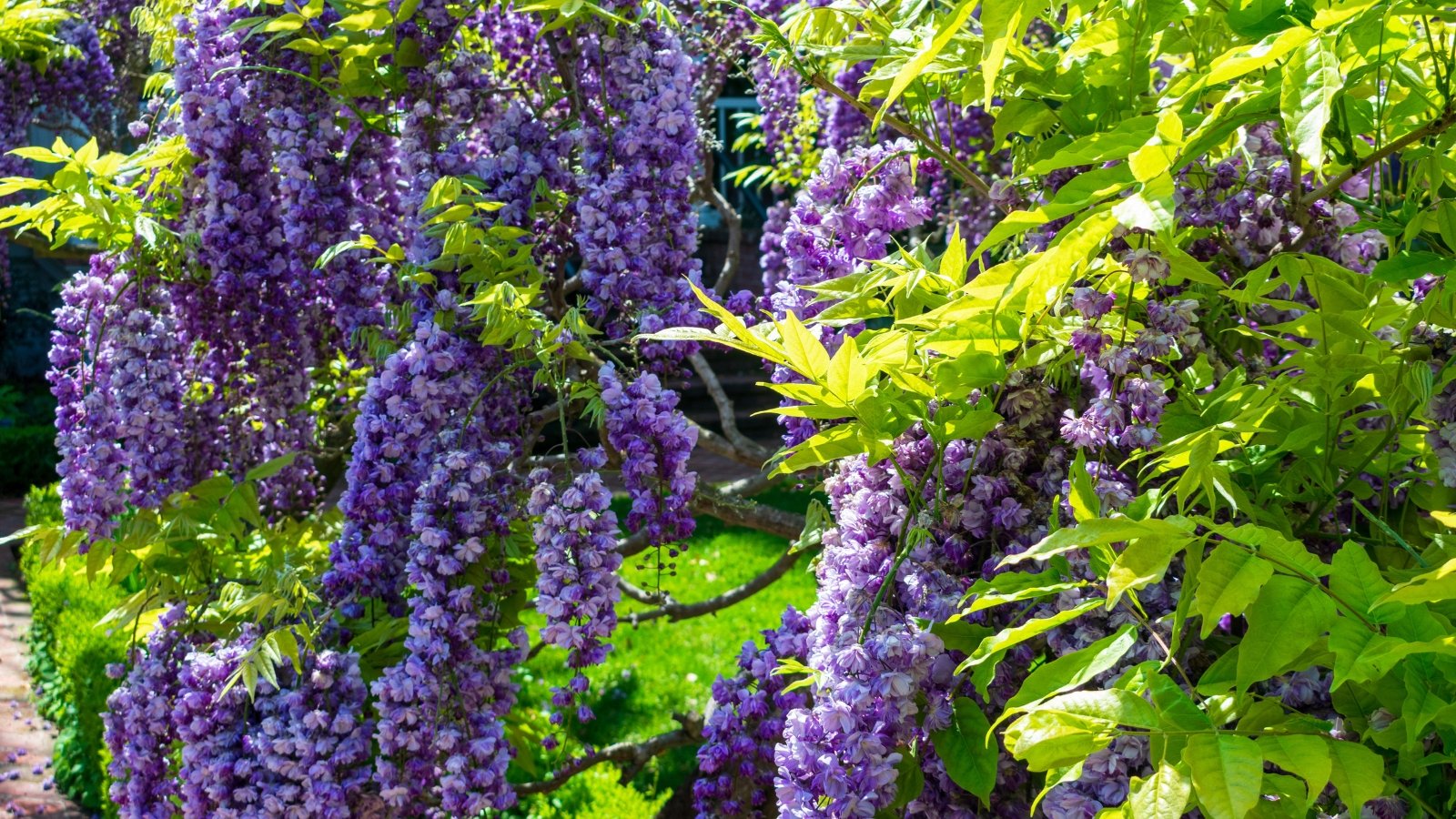
Many of the wild vines we see are of Asian origin, becoming popular in the early 1800s. These are invasive in many growing areas. The hardy vines spread through suckers and seeds and grow well in varying conditions. Chinese wisteria (Wisteria sinensis) blooms in spring in a flush before leaves emerge. The flowers open all at once. Japanese wisteria (W. floribunda) has larger blooms with buds that open from the top down in a waterfall of blossoms after the leaves emerge. Both species bloom on old wood.
W. frutescens, American wisteria, and W. macrostachya, Kentucky wisteria, are noninvasive, native North American species. Kentucky wisteria, once an American subspecies, is now its own species. Both are beautiful bloomers with vigorous, leafy vines that don’t spread uncontrollably. These bloom on new wood.
‘Amethyst Falls’ and ‘Blue Moon’ are popular varieties that grow well in beds and containers, on pergolas, and as tree forms. ‘Amethyst Falls’ is an American cultivar that reaches 30 feet tall. It flowers three weeks later than the Asian species, allowing extra protection against late-season frost damage to the flowers.
‘Blue Moon’ is a Kentucky selection with more compact growth at 15-25 feet tall. After its initial flush, it may repeat bloom two to three times in spring and summer. The variety is cold hardy to zone 3.
All wisterias are weighty vines that need a sturdy support system like an arbor, arch, or wall. Use heavy beams or steel wire and avoid delicate wooden latticing.
Prune Wisteria Twice A Year

If you don’t have space for running and rambling vines, prune twice yearly to benefit the plant. With regular trimming, the need for severe cutback lessens. This practice allows us to keep the size in check and promote future flowering. Prune wisteria twice yearly, initially in late winter or early spring before new leaves emerge and again in mid to late summer.
The blooming vines respond well to trimming. At any time of year, cut or dig runners and shoots as they sprout at the plant’s base. Removing the shoot controls the spread, especially in Chinese or Japanese varieties. At any point, remove diseased, damaged, or crossing canes.
Heavily in Late Winter
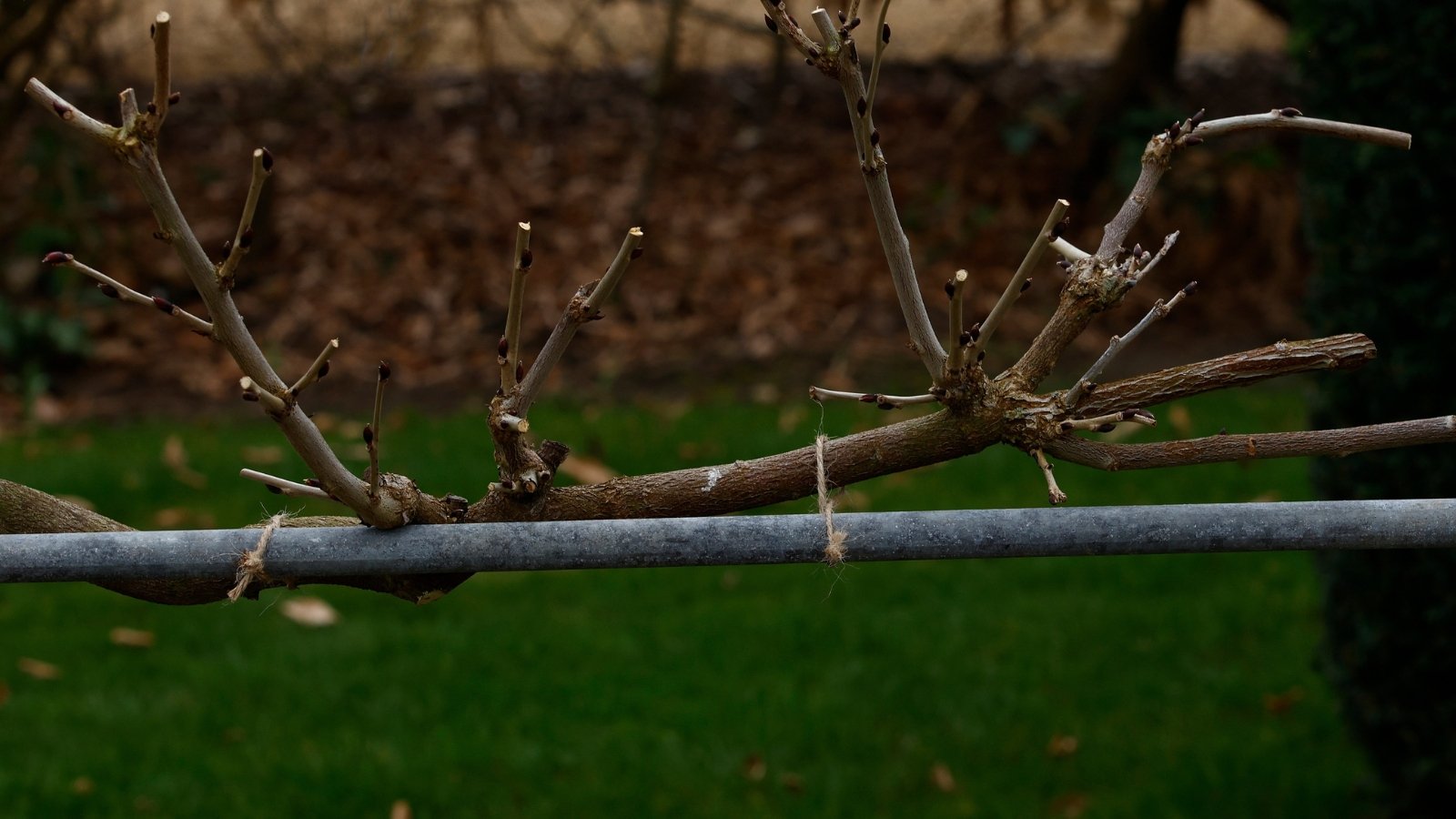
In late winter, it’s easy to see the form of the plant with leafless branches. This is the time for a heavy cut. Winter trimming aims to direct the plant’s energy into bud development rather than leaves. Cutting stems in January or February harnesses nutrients to the plant parts that remain, including the previous year’s growth with developing buds.
For American and Kentucky wisteria, which bloom on new wood, a winter cutback makes way for new stems to grow and set buds for the current spring.
Lightly in Summer
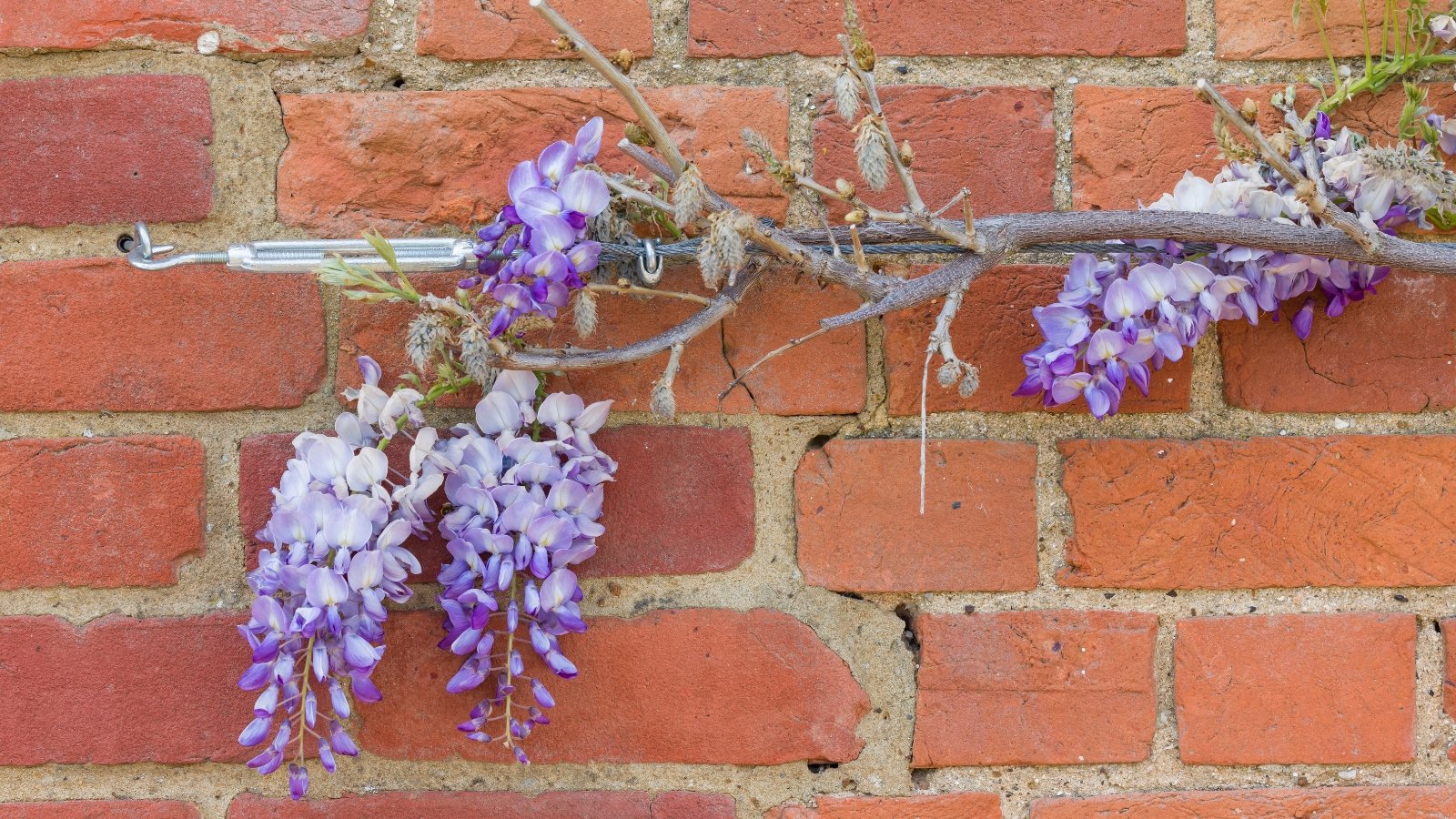
A second pruning is best after the flowering period to control growth and size. This is usually in July or August. Summer pruning is a lighter trim for shaping and removing excessive foliage. This light cut prepares for winter pruning and makes that round easier.
Minor pruning is useful during the growing season to prevent plants from overwhelming their supports or other plants. For young plants, pruning within the first three to five years is for shaping and directing growth. As you establish the plant’s form and train it to grow on support structures, select branches to retain and trim away crowded areas.
Assess Pruning Needs
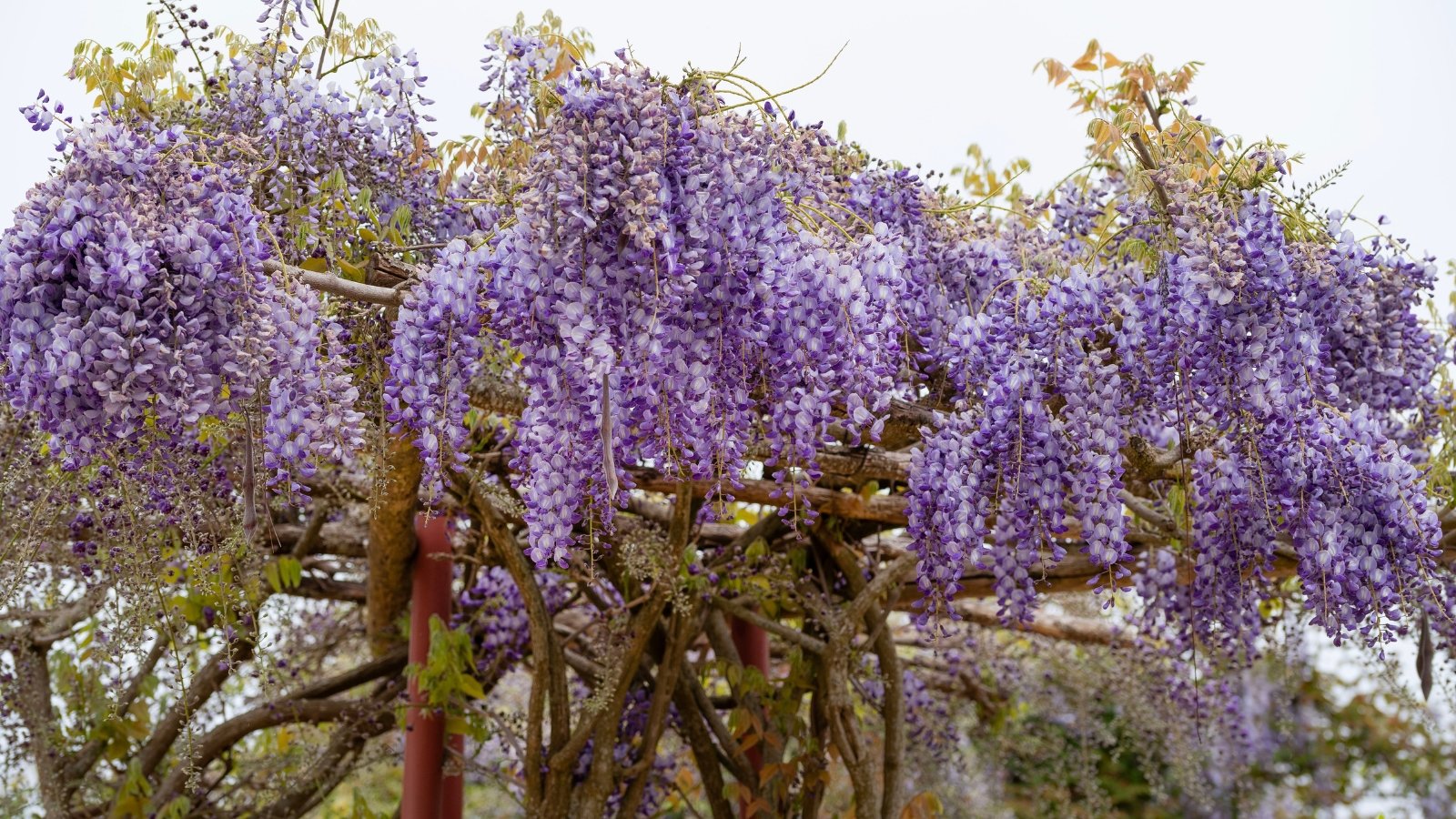
Wisteria are exceedingly resilient plants. Pruning is straightforward, and there’s no need to fret about making mistakes. The need for pruning is also the most “high maintenance” quality of the easy growers.
Depending on the state of your vine, cutting may involve removing lots of bulky material. This bulk is usual, especially as you undertake a pruning schedule. Determine the needs of your vine.
Routine Maintenance
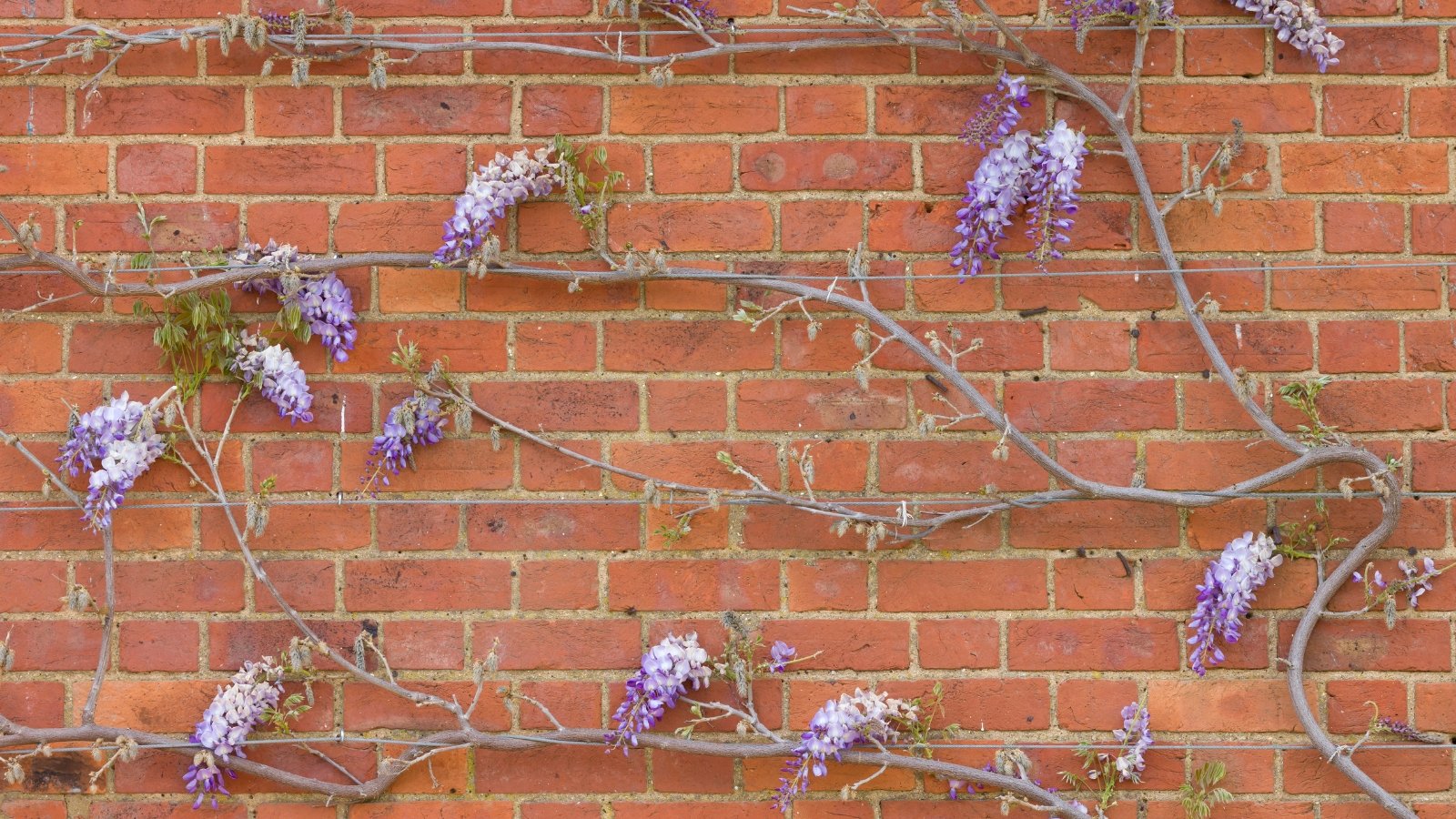
Routine pruning refers to the winter and summer protocols. Hand pruners, loppers, and a small handsaw are tools for the job. In summer, remove about half the length of new vines, leaving 12 inches or five to six leaves. Cut stems just above a leaf node. This alleviates dense vines and overcrowding and promotes energy to the shorter spurs.
In winter, clip summer-cut stems to six inches, leaving two to three buds per branch. Cut just above a bud. The remaining short stems and buds produce large flowers; leaves won’t obscure the colorful pendants. Cut back wimpy vines to encourage bud development rather than an overage of new foliage.
For Kentucky varieties, prune lightly in the summer, taking care not to remove many buds since it free-flowers all season.
Hard Cutback and Rejuvenation
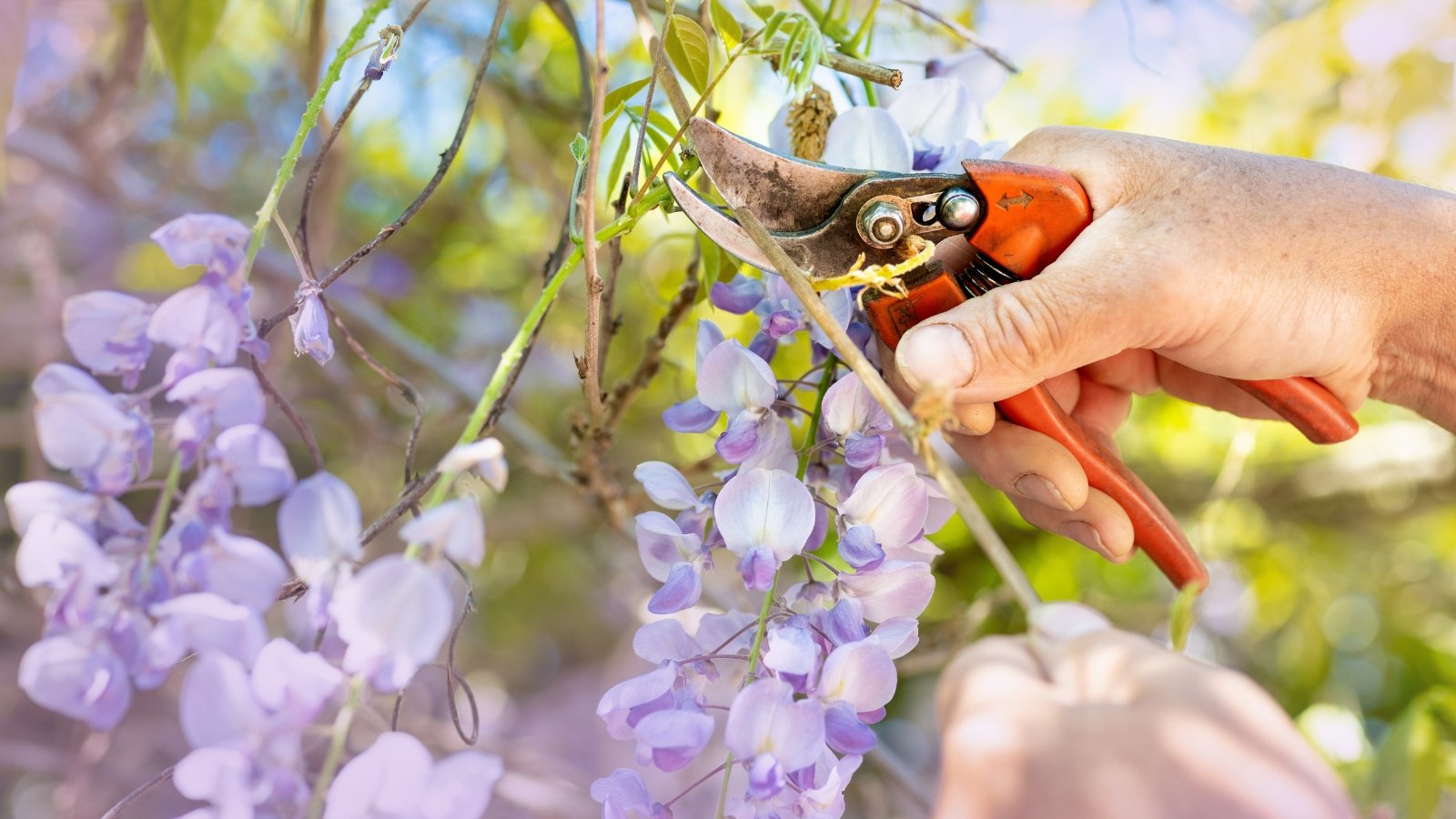
If an established plant is overgrown, obscuring the support structure or encroaching on other areas, a hard prune may be necessary to reduce the scale. Late winter is the time for this rejuvenation pruning. The goal is to gain a well-spaced framework to support future growth.
In extreme cases, the vine may need to be cut back to the ground and allowed to regrow. Otherwise, shorten long branches, remove older stems just above a new shoot, or cut them back to a main branch. Cut entire branches to the primary trunk as necessary to regain shape.
After a hard prune, new vegetative growth will be vigorous. Train new growth to fill in any gaps. Flowering resumes in two to three years after severe cutback. As part of regular maintenance, continue removing misdirected branches as they grow.
Training
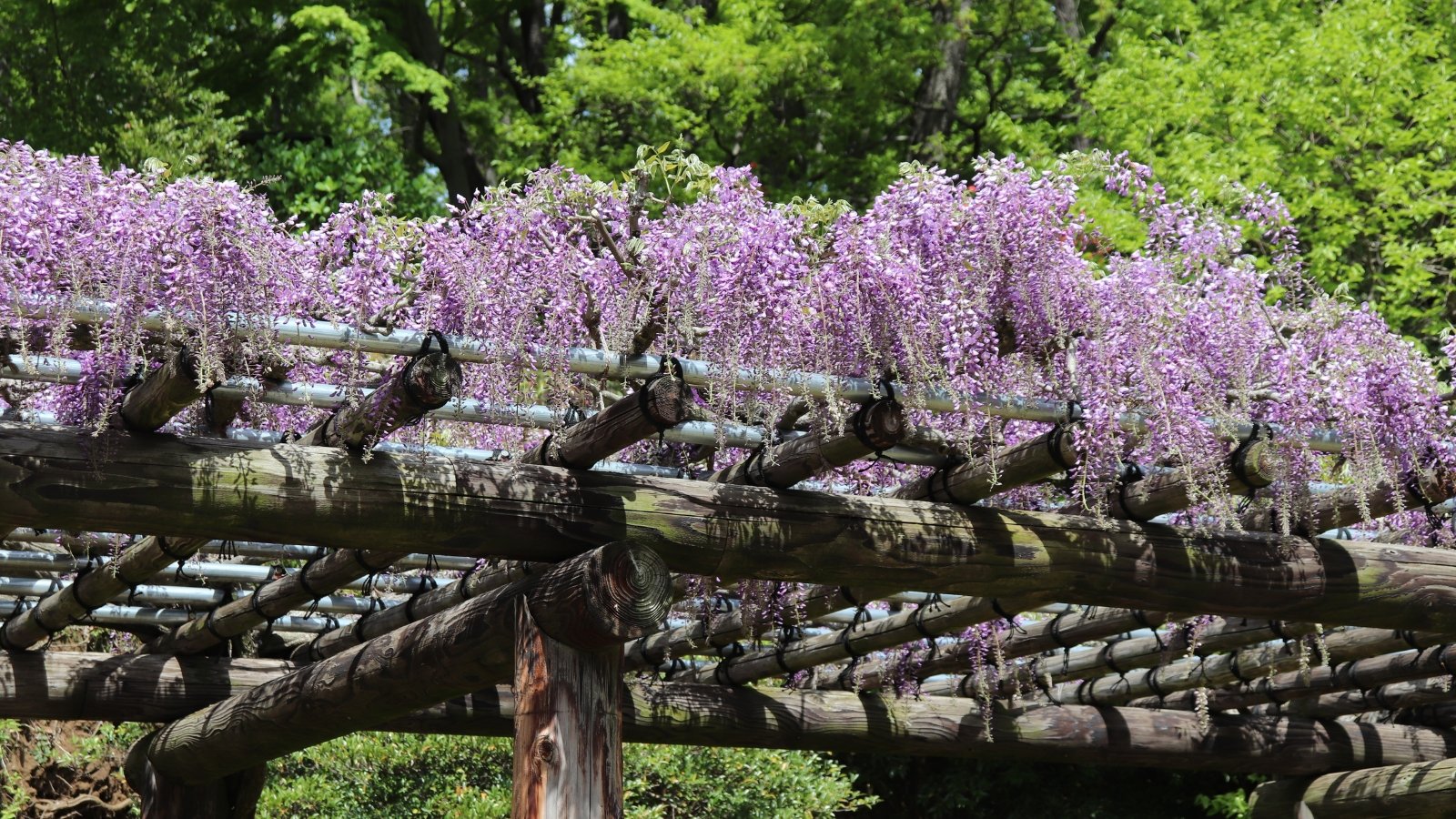
Vines growing on walls, pergolas, arbors, and arches need training to direct their energy. To grow wisteria on a wall, use espalier techniques for horizontal growth. Steel wires at one-foot intervals support the robust vines on the face of the wall.
Growing vertically on pergolas, arbors, and arches allows supreme enjoyment of the hanging, voluminous blooms. Train primary canes along the structure, tying them in place. Cut away excess shoots, relying on seasonal new growth for infill.
Regular, routine trimming helps direct growth. If needed infill with new shoots after removing old canes for shaping. Hearty trunks and branches develop to support new stems.
Tree Form
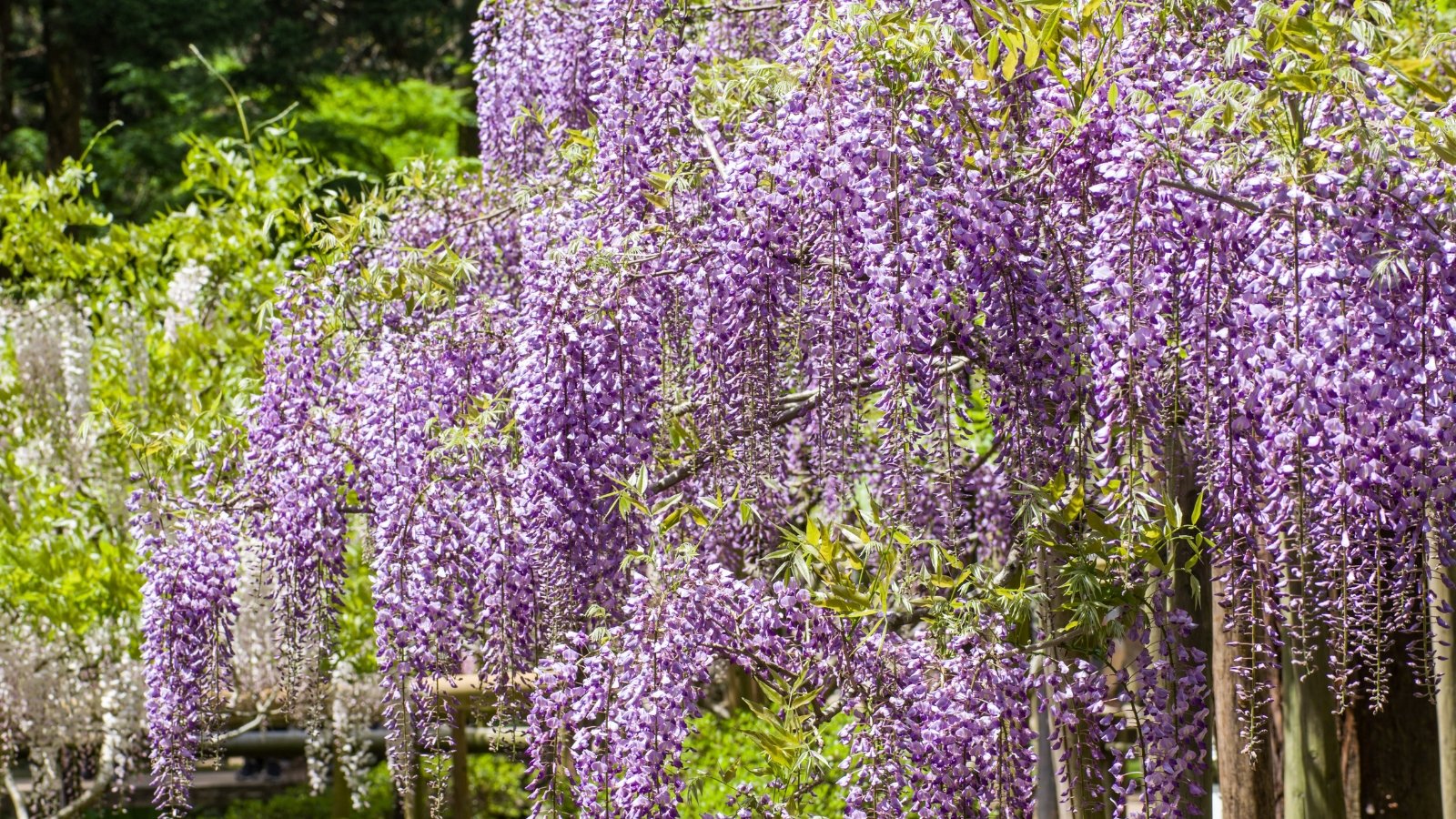
Train wisteria into a canopy form or small tree with the support of a metal pole. With routine shaping, a sturdy trunk will develop with leafy upper branches. Retaining a tree form or standard can be a challenging method to prune wisteria, but it’s a unique way to enjoy the plant. Standards grow as specimens in the ground or containers.
Train a primary leader stem to grow vertically around the support post. When it reaches the top, remove its growing tip. Removal promotes lateral expansion from side shoots to create the canopy.
Prune wisteria each summer and winter with regular guidelines for shape and flowering. Brush away buds from the main stem.
Deadhead
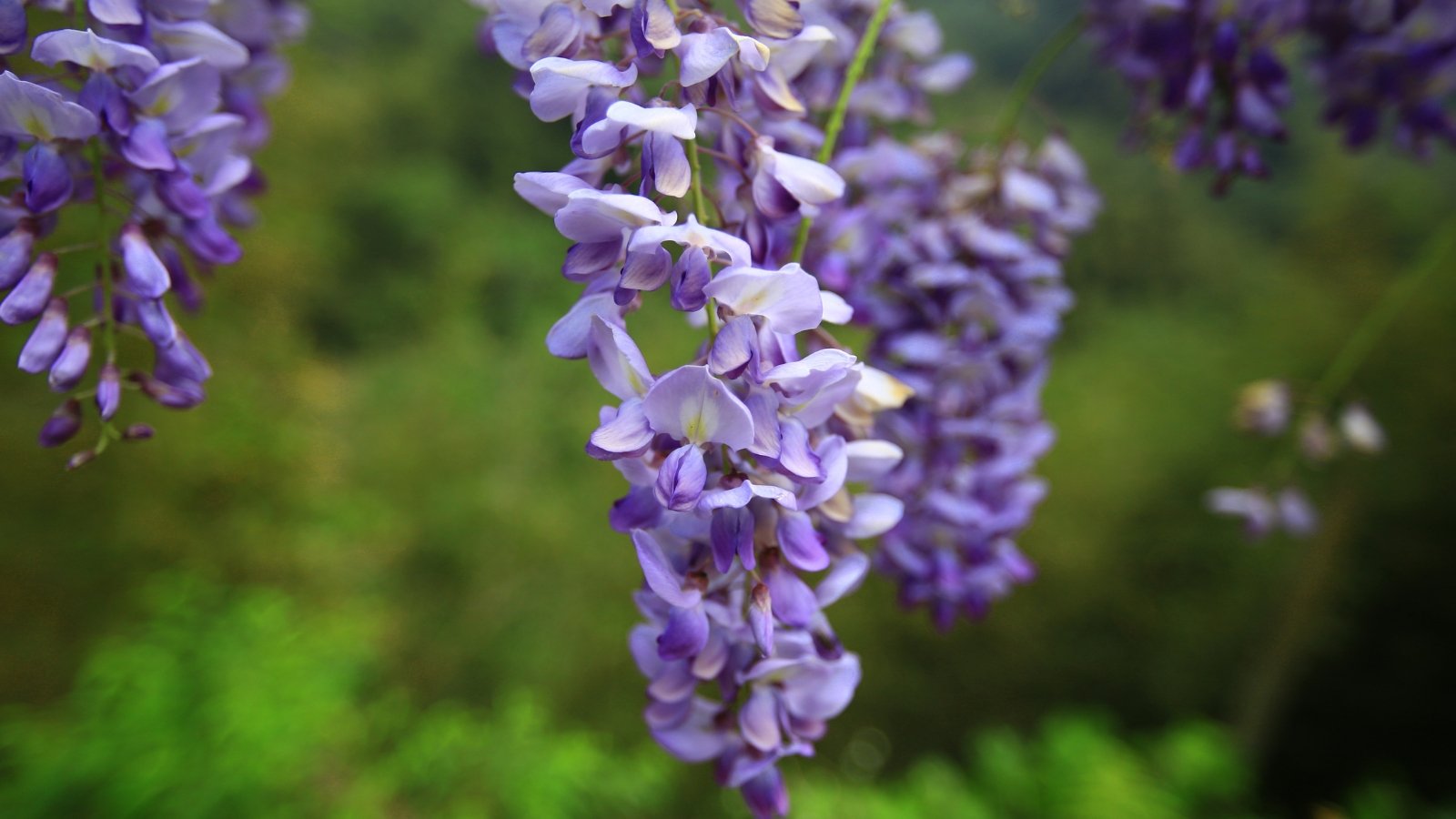
With tall vines, deadheading isn’t always feasible. When it is, removing spent blooms promotes further flowering and bud development. It also prevents plants from reseeding, which is especially important for Chinese and Japanese species.
Clipping spent flowers is quick and easy. It helps by:
- Improving form and growth habit
- Encouraging further flowering
- Preventing seeding
Deadhead when flowers begin to lose their color and fade. Petals will droop, wither, and drop.
To deadhead, cut off a single flower or cluster as it fades. Cut stems back to a healthy set of leaves, whether just behind the spent bloom or further down the stem, for light shaping and regrowth.
Remove seed pods, especially on invasive varieties, to prevent self-seeding. Be mindful of removal and disposal: wisteria seeds and velvety pods are toxic to people and pets.
Frequently Asked Questions
These vigorous flowering vines benefit from pruning in late winter or early spring before new growth appears. Cutting plants back or shaping existing stems encourages well-spaced branching and full buds. A lighter trim in summer, post-flowering, controls growth during the warm season.
Chinese and Japanese wisteria bloom on old wood, the previous season’s growth. American and Kentucky wisteria, North American natives, and their cultivars bloom on new wood or the current season’s growth.
These robust plants don’t need pruning to survive. They’ll climb and sprawl with loose, vegetative growth. Due to their vigor and adaptability, Chinese and Japanese species are invasive in many areas. For both Asian and American species, pruning helps control and direct growth and channels energy into bloom production.




